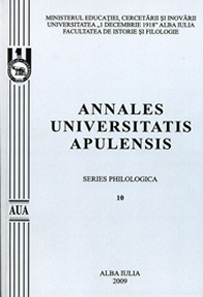Coding and Behavioural Properties within Grammatical Relations
Coding and Behavioural Properties within Grammatical Relations
Author(s): Madalina CerbanSubject(s): Language and Literature Studies
Published by: Universitatea »1 Decembrie 1918« Alba Iulia
Keywords: grammatical relations; semantic roles; coding properties; behavioural properties
Summary/Abstract: The purpose of this article is to discuss grammatical relations in a sentence within a relational framework, and to make a comparison, wherever possible, between English and Romanian language. The notion ‘grammatical relation’ is well established (Blake, 1994: 48–93, Palmer 1994, Givón 2001: 173–232), being a theory of descriptive grammar in which syntactic relationships define better grammatical processes than syntactic structures. The central idea of relational grammar is that there is a limited number of grammatical relations (Subject [SU], Direct Object [DO], and Indirect Object [IO]), such that one term can bear more than one such relation at different levels or 'strata' of the structure underlying the clause. In other words, relational grammar conceives of a clause as a network of grammatical relations. We concentrate especially on syntactic aspects because many important syntactic phenomena involve grammatical relations and, as a result these concepts would be important for the description and for the explanation of these phenomena. Grammatical relations have two different properties: coding and behavioural. Our discussion starts from the assumption that behavioral properties are acquired historically prior to subject coding properties. Coding properties are, to a large extent, morphological while behavioural properties are syntactic, taking into account the involvement of a particular relation in grammatical constructions. In this paper we will analyse only constructions in which the Subject is an actor in transitive predications, the Direct Object is an undergoer in a transitive predication, and the Indirect Object is a recipient or a goal in ditransitive predications. (i) Coding properties. The most important coding properties are verb agreement, case marking and the functions an argument can perform in a sentence according to its place in the sentence. The first two coding properties are morphological while the third one is syntactic. We also demonstrate that no coding properties that can identify any grammatical relation. (ii) Behavioural properties refer to the types of constructions they can appear in. If a construction refers to a specific term in a language, then involvement in that construction is a property of the particular grammatical relation in that language. The analysis of the relational syntactic construction tries to identify the restrictions that make that construction particular. The most important syntactic parts that can be discussed in terms of behavioural properties are Subject, Direct and Indirect Objects, but in this paper we will concentrate on the Subject which is targeted by the largest number of syntactic phenomena.
Journal: Annales Universitatis Apulensis. Series Philologica
- Issue Year: 11/2010
- Issue No: 2
- Page Range: 170-183
- Page Count: 14
- Language: English

